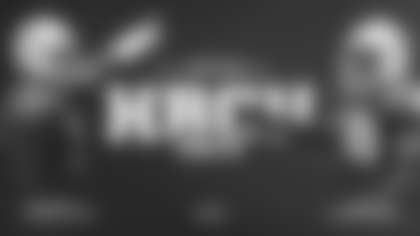INDIANAPOLIS–* *Tom Moore is the first person to deflect any form of praise. Moore has done it religiously throughout his career. On Sunday at Lucas Oil Stadium, he will have to do it in front of approximately 65,000 people.
The long-time NFL veteran coach will be cited by the Colts for his contributions to the team. A football lifer who is closing in on a half-century of coaching, including almost 35 years in the NFL and nearly a quarter-century as an offensive coordinator, Moore stands as one of the most revered figures of the club's coaching history.
Of his years in Indianapolis, Moore says, "It means a lot to me to be part of a situation where people have had success and the enjoyment that goes with it. It's not for me. It's very much for the players. I've always been a big 'players' guy. I'm for the players. Nobody has any idea how much hard work and dedication they put in to have the success that they've had. It means a lot to me that the players have enjoyed that success."
Moore knows any success in the NFL comes through organizational strength. He is quick to laud Owner and CEO Jim Irsay and Vice Chairman Bill Polian.
"In my mind, he is the finest owner in the National Football League," said Moore. "Anything that has success, it always starts from the top down. Jim Irsay as an owner and as a friend is tremendous. It was a privilege and honor to work for such a great man.
"I don't think Bill Polian has an equal in the NFL. His knowledge of the game, of drafting people and knowing who to draft and how to spot players, to me, is unparalleled. The success he has had maintaining the program over a long period of time in the era of free agency is unsurpassed. He has no equal. He may be the best who ever has been in the sport as a general manager and talent evaluator."
Moore came to Indianapolis in 1998, Irsay's second year as owner and the first year of the Polian era. The fortunes of most teams come largely through the draft, and the first draft of the era included Peyton Manning as the top pick. Subsequent drafts would yield significant talents like Edgerrin James, Reggie Wayne, Dwight Freeney, Robert Mathis, Dallas Clark and many, many others. Free agency additions like Jeff Saturday, Mike Vanderjagt, Gary Brackett, Adam Vinatieri and Dominic Rhodes aided the process, along with having veteran talents like Marvin Harrison and Tarik Glenn already on hand.
Indianapolis took flight in 1999 with a 13-3 record that included a division title, and Moore was a component along the way. In time, accomplishments would pile up for the organization. In the NFL's 91 seasons, there have been only 37 offenses that featured a 4,000-yard passer, a 1,000-yard rusher and a 1,000-yard receiver. Moore helped Indianapolis accomplish the feat seven times (1999-2001, 03-04, 06-07). His 1999 unit had Manning with 4,135 yards, James with 1,553 yards and Harrison with 1,663 yards, marking only the second NFL offense ever with 4,000-1,500-1,500 performers. The only other team to do so was Detroit in 1995. The offensive coordinator was – Tom Moore. Yes, that Tom Moore.
In 2000, Manning and James led the NFL in their categories, marking only the second time in NFL history, the first since 1937, one team had the passing and rushing champion. During his entire tenure (1998-2010), Indianapolis had 141 wins, nine consecutive playoff appearances, a league-record seven straight seasons with 12 victories, a league-record 23 consecutive regular season wins (2008-09), eight division titles, three conference championship game appearances, two AFC Championships and one World Championship, Super Bowl XLI. Nine times the club's offense ranked in the league's top five, five times it led in third-down conversions, eight times it ranked in the NFL's top three in scoring and seven times it ranked first in fewest sacks allowed. The team had 13 straight seasons of 5,000 net yards and scored 400 points 10 times. Manning won an unprecedented four AP Most Valuable Player honors. There were multiple players earning Pro Bowl and All-Pro honors. James won two rushing titles (1999, 2000).
Moore continually stresses where the credit goes – Jim Irsay, Bill Polian, Head Coaches Jim Mora, Tony Dungy, Jim Caldwell and the players. His doggedness in deflecting credit and feeling satisfaction for others seems to leave no sliver of pie for himself.
"It means a lot to me to be associated with it for Jim Irsay and Bill Polian," said Moore. "The hard work they have put into it as an owner and general manager to try to create the situation to succeed is very difficult. Through Jim Irsay's efforts and Bill Polian's efforts, we turned the corner and made it a football state. That means a lot to me. I'm for the players. I am happier for them than I am for me. The other people I am tremendously happy for are the people in Indianapolis. The fan support has been great. They love their football. Those are the most important people I was concerned with. Don't worry about me. It never was about me."
Positioning others for achievement and success is what drives Moore the most. While numerous players have succeeded, perhaps no one has more than Manning.
Manning started the first 208 regular season games of his career, the most in NFL history by any player. He has 11 Pro Bowl nominations, nine consecutively. His four MVP titles are a league standard. He is the only player in the Super Bowl era with 11 double-digit victory seasons and the only player ever with nine straight seasons with 10 starting wins. He is the only player to have 3,000 yards and 25 touchdowns in 13 career-opening seasons. His 11 4,000 seasons are a league record. With 399 touchdowns and 198 interceptions, he is the only player ever with 200 more touchdowns than interceptions. His 141 starting wins rank fourth in history.
Manning has said he never will forget what Moore meant to him. It was a solid relationship from the outset.
"There's no question Tom Moore has had an impact on a lot of wins here, a lot of football players here, a lot of coaches," said Manning. "For me, I'll always be indebted to him for what he did for my career. I remember getting drafted in April of 1998 and came to Indianapolis the next weekend for the mini-camp. I spent every night late over here (the office) with Tom and we crammed (the offensive principles). I really felt I learned the offense quickly because of the sessions Tom and I had together, which was very comforting for me being a rookie quarterback and being named the starter, having knowledge of the offense even better than some of the veteran players. Tom really took the time to work with me early. We just had a great relationship over the years. The trust that he gave to me grew throughout our time together, which I appreciated. I worked hard to try to earn that.
"He was very fair to players. He demanded a lot out of his players. Players respected him, though, and worked hard for him and wanted to win for him. That's a great quality of a coach, I think."
Manning is known to be a quarterback on the prowl for any weakness. That trait was shared by his coordinator, who had the same visual impression, too.
"Tom was very intense. He's was an aggressive offensive coordinator. He was an aggressive play-caller," said Manning. "You can remember many of times on third-and-one or fourth-and-one he wasn't afraid to go deep and down the field. Against Green Bay (in 2004), we threw it the first 22 plays of the game. He was an aggressive guy who had great confidence in his players to execute the plays he called. He had no fear as a play-caller. Tom and I spent basically every day meeting together, along with Jim Caldwell, or (offensive coordinators) Bruce Arians or Clyde (Christensen). I can't think besides my family who I have talked to the most (other than Moore). He's talking to me the most on game day. He's got the headphones (on), and he's talking to me in my ear. I've had more conversations with Tom than just about anybody during my time here.
"(He's) a special coach, kind of a 'throwback' coach, 'old-school' philosophy, if you will. It was efficient and effective, and it helped us win a lot of football games here."
The impressive numbers the offense posted for years had to do with an 'old school' mind that could adapt to current situations, specifically the talents of his players. As Moore always said, 'It's the players, not the scheme.'
"Tom's philosophy was he was going to kind of base the offense around the players he had," said Manning. "He would utilize Dallas Clark to his (Clark's) strengths. He would utilize Edgerrin James, Marvin, Reggie. He would try to play to my strengths. It's a combination, certainly players have to go out there and execute it, but coaches have to put you in the best position. Tom was very demanding in practice during the week. He held everybody accountable to do what they were supposed to do. If you made a mistake, he would let you know about it. Players always were very respectful of him, appreciated his history, of all the places he'd been and places he'd won. I think that served Tom well."
Being true to oneself is crucial in any line of work, particularly when leading a group of people. Moore was blunt, honest and direct. Players responded.
"No question. He was very fair," said Manning. "He was upfront and honest with the players from the get-go. I think players appreciated it. There are different ways of getting players to respond, and Tom's method worked."
As the years moved on, Manning grew comfortable enough to change plays at the scrimmage line. The offense evolved over 13 years. Moore may have been the roots and trunk of the tree, but Manning was part of the life-line, too. About two to three years into the process, the offense started taking the shape that America began to notice.
"It sort of developed over the course of a couple of years," said Manning. "Around 2000, 2001, 2002 was when we started tinkering a little bit with the no-huddle. It was kind of on occasion at that point. We used to do it if we started out a game slow. If we came out and had a three-and-out, three-and-out and we'd punt, we'd say, 'Hey, let's try to get a little rhythm going, let's go no-huddle.' Every time we did it, we'd always go down the field and score. Finally, Tom just said, 'Why do we have to wait until we punt twice to try to get into that rhythm?' We just started the game that way. It was pretty innovative. You see a lot of teams now doing a lot of the no-huddle. I think Tom deserves a lot of credit for that, for being an innovator. Our offense has developed. We were so much two tight ends with Ken Dilger and Marcus Pollard (around 1999-2001), because that was the strength of our team. Once we got Brandon Stokley (in 2003), we were a little more of a three-wide receiver team. Then Dallas, of course, gave you great flexibility. It kind of shows how he (Moore) was flexible. Tom was not what I would call a stubborn offensive coordinator. He wasn't going to say, 'This is what we're going to do. This is how we've always done it, I don't care.' He was going to say, 'This might be the better course of action to take.' He was flexible, which I think is another good quality for a good offensive coordinator. He was going to adjust, based on the strengths of his players."
Irsay has presided over the franchise's successful tenure. In addition to a keen football mind, Irsay has an innate sense of history as well. In Irsay's estimation, Moore is a large figure in a successful history.
"Tom Moore is one of the significant figures in the history of the Colts," said Irsay. "Tom is the last person who wants attention, but he is a key reason the team achieved so much for so long. Tom coached aggressively. He always looked to attack defenses. He attacked them smartly and relentlessly. Tom understood every game was there to be won, and he expected to win. He would not accept anything less from himself and the players he coached. Tom was direct in his teaching approach and people responded to him. He was a tactician in the meeting room, and he was a driven coach on the practice field. His results are evident in the offenses he coordinated. His visual presence on the sideline was a welcomed site by everyone who loved the Colts. I express my deepest gratitude and fondness to Tom and his wonderful family. He contributed so much to our success."
Polian is respected as one of the game's brightest minds and organizational architects. His football blueprint helped create one of the best runs in NFL history with the Colts. Polian recognizes Moore's importance in the achievements.
"Tom Moore was instrumental in the decision to draft Peyton Manning," said Polian. "Tom designed and continued to re-engineer an offense specifically tailored to Peyton's talent and skills. In addition, his offensive genius and flexibility allowed talent to flourish at the other offensive skill positions for well over a decade. From Ken Dilger and Marcus Pollard to Dallas Clark and Jacob Tamme; from Marvin Harrison to Reggie Wayne to Austin Collie to Pierre Garcon; from Marshall Faulk to Edgerrin James to Dominic Rhodes to Joseph Addai. All reached their full potential under Tom Moore.
"Tom was and is the epitome of a professional and a champion. His genius was on display on game day. His work ethic, physical and mental toughest he transferred to his players each and every day on the practice field and in the meeting room. The end product was a record-setting offense and championships.
"Tom Moore was the on-field architect of the Colts' championships. In addition, those of us who treasure and respect him so much know he is a Hall-of-Fame person as well as a Hall-of-Fame coach."
Caldwell was the club's quarterbacks coach starting in 2002 before gaining the titles of assistant head coach and associate head coach before taking the head coaching position in 2009. He spent numerous hours in staff meetings with the offense through the years and knows the imprint Moore had on the attack.
"They're immeasurable, really," said Caldwell. "Tom had a wealth of knowledge and experience. (He was) very, very good at implementing systems, a very, very good instructor and a very effective teacher. He had a straight-forward, hard-nosed approach to everything. The thing that I think between he and Peyton (Manning), they had a great synergy because of the fact that Tom was a very aggressive play-caller and Peyton's a very aggressive quarterback. I think the two of them just had an unusual sort of a relationship just in terms of knowing what the one wanted and what the other one wanted. Most often it was one in the same, yet there was a great amount of trust there, too, between both parties. Tom's an innovator. Tom was a guy that, we didn't change a whole lot but when we did make an adjustment here or there, it certainly made a difference in a number of the games that we played. A great man, a great coach and a lot of fun to work with."
Moore peppered players and those around him with unique expressions and truisms that stand now as 'Moore-isms.' Ask coach or player, former or current, about 'Moore-isms' and the responses would include: Play Smart, Not Scared…No Guts, No Blue Chips; It's who goes the hardest….the longest; Don't be showing your old coaches our playbook. Tell them to wake themselves up earlier and work a little harder; I hope you come from a rich family because it would be a shame if you can't make this team because you can't stay onsides; Get up and run…Hurry on…Ya gotta luv it; We're going to take all the mystery out of it. We have no half-speed routes; If you keep throwing the ball in there, they'll be carrying him out boots first; Goal-line is two guys in a phone booth, either you kick his butt or he kicks yours; Don't say, 'My bad,' just say you (messed) up.
Moore (Indianapolis, Pittsburgh) is one of 24 NFL coaches to win a Super Bowl with more than one team. Moore was a quarterback at Iowa from 1957-60. He coached at Iowa from 1961-62. Following a two-year stint in the Army (1963-64), where he coached a division team in Korea and the post team at Fort Benning, Ga., Moore served as offensive backfield coach at Dayton from 1965-68. He served as offensive coordinator at Wake Forest (1969) and offensive backfield coach at Georgia Tech (1970-71) before assuming the offensive backfield position at the University of Minnesota (1972-73). Following a 1974 WFL stint with the New York Stars, Moore returned to Minnesota as offensive coordinator from 1975-76.
He spent 1977-89 with Pittsburgh. Moore coached receivers from 1977-82 before assuming the role of offensive coordinator and quarterbacks coach from 1983-89. He helped lead the Steelers to victories in Super Bowl XIII (35-31 over Dallas) and Super Bowl XIV (31-19 over Rams). He moved to Minnesota (1990-93), serving as assistant head coach/quarterbacks (1990), assistant head coach/offensive coordinator (1991) and receivers coach (1992-93). He then joined Detroit as quarterbacks coach in 1994 and was offensive coordinator from 1995-96. During that three-year span, Barry Sanders ran for nearly 5,000 yards with a 5.2 average. In 1995, Detroit led the NFL in total offense (6,113 yards, 382.1 ypg.) and became the first NFL team to have two receivers post 100 receptions (Herman Moore, 123-1,686, 14 TDs; Brett Perriman, 108-1,488, 9 TDs). The 3,174 combined yards by Moore and Perriman set the NFL seasonal tandem yardage record. Moore moved to New Orleans in 1997 as running backs coach.
Moore earned a bachelor's degree in history at Iowa and a master's degree in guidance counseling at Dayton. In 2005, Moore was inducted into the Rochester, Minnesota Sports Hall of Fame.* *He was born November 7, 1938, in Owatanna, Minn. He is married to the former Emily Dickerson of Charlotte, N.C. They have two children, Terry and Dan.
"My whole life has been living a dream," said Moore. "I played the game. I was never that great, but I enjoyed it. I played it in college. We had success in high school. We were 27-1 and won a state championship. At Iowa, I was never a great player there, but I was part of a team that was a national champion and won a Rose Bowl. Then I got an opportunity to coach in college and pro football with great organizations. I worked for great head coaches. Everything I learned in pro football, I learned from Chuck Noll. He may go down, in my opinion, as the greatest head coach that's ever been in the NFL. He has four Super Bowl wins in six years to prove it. To coach all the great players and work with all the great coaches and to work for the great owners that I've been privileged to do, it's living a dream. Not many people get a chance to live a dream."
Moore often remarked his greatest coaching years were in Indianapolis. He has a message for Colts fans.
"The Colts fans are the greatest," said Moore. "They stuck with us, they hung in there with us and each successive year you would go to away games, you kept seeing more blue shirts, and more blue shirts, and more blue shirts. … I don't think you can say enough about the city fathers and the way they planned the city of Indianapolis and got it involved in all it is involved in. In the 13 years I was there, the town football-wise went from trying to get people to come, then they packed the stadium, then we went to the Super Bowl, then you get a new stadium and go to the Super Bowl again, and now the Indianapolis fans have a Super Bowl coming to them. I think that speaks volumes for the city and the fans."
As for the club's iconic horseshoe logo which is among the most recognizable in American sports, Moore looks at it with a special meaning.
"When you sit and look at the Colts' horseshoe logo, it has the seven holes where you put the nails in to secure the horseshoe on the hoof," said Moore. "I think of those seven holes and what they mean to me are, 'It is great to be a Colt.' That's what the horseshoe means to me."
Moorespent time recently with Colts.com for a lengthy question and answer session. Visitwww.colts.com* on Sunday morning for Moore's interview.*













